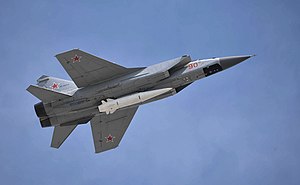| Kh-47M2 Kinzhal Х-47М2 Кинжал | |
|---|---|
 A Kh-47M2 Kinzhal being carried by a Mikoyan MiG-31K interceptor | |
| Type | Air-launched ballistic missile |
| Place of origin | Russia |
| Service history | |
| In service | 2017–present |
| Used by | Russian Aerospace Forces |
| Wars | Russian invasion of Ukraine |
| Production history | |
| Designer | Believed to be: Votkinsk Plant State Production Association and Tactical Missiles Corporation JSC |
| Unit cost | US$10 million[1] |
| Specifications | |
| Mass | 4,300 kg (9,500 lb) |
| Length | 7.2 m (23 ft 7 in) (estimated) |
| Diameter | 1,200 mm (47 in) (estimated) |
| Wingspan | 1.6 m (5 ft 3 in) |
| Warhead |
|
| Engine | Solid-propellant rocket motor |
Operational range | 2,000 km (1,200 mi) (Including range of launching aircraft) |
| Maximum speed | up to Mach 10 (3,400 m/s; 11,200 ft/s) |
Guidance system | INS, mid-course update |
Steering system | Four cropped delta‐fins |
Launch platform |
|
| References | Janes,[2] CSIS[3] |
The Kh-47M2 Kinzhal (Russian: Х-47М2 Кинжал, romanized: kʲɪn'ʐaɫ, lit. 'Dagger'; NATO reporting name: AS-24 Killjoy) is a Russian hypersonic air-launched ballistic missile.[4][5] It has an estimated range of 460–480 km (290–300 mi)[6] and a reported top speed of Mach 10.[3][6] It can carry either conventional or nuclear warheads[7] and can be launched by Tu-22M3 bombers, MiG-31K interceptors, or modified Su-34 fighter-bombers. It is the first hypersonic weapon used.[8]
It has been deployed at airbases in Russia's Southern Military District and Western Military District.[9][10]
The Kinzhal entered service in December 2017 and was one of the six new Russian strategic weapons unveiled by Russian President Vladimir Putin in March 2018.[11]
- ^ Cite error: The named reference
7402408 Kinzhalwas invoked but never defined (see the help page). - ^ Janes (14 April 2022), "Kh-47M2 Kinzhal (AS-24 'Killjoy')", Janes Weapons: Air Launched, Coulsdon, Surrey: Jane's Group UK Limited, archived from the original on 11 March 2024, retrieved 13 March 2023
- ^ a b "Kh-47M2 Kinzhal". Center for Strategic and International Studies. Archived from the original on 10 October 2022. Retrieved 13 June 2023.
- ^ "Kh-47M2 Kinzhal". Missile Threat. Archived from the original on 10 October 2022. Retrieved 20 June 2023.
- ^ "Russia unveils Kinzhal hypersonic missile". www.janes.com. Jane's 360. Archived from the original on 23 July 2018. Retrieved 16 March 2018.
- ^ a b Yap, Marc (11 August 2023). "Deriving the Kinzhal Missile's Actual Range and Speed: An Aerospace Engineering Analysis". Medium. Archived from the original on 3 January 2024. Retrieved 3 January 2024.
- ^ Majumdar, Dave (10 May 2018). "Russia Places 10 Deadly MiG-31s on "Experimental Combat Duty" to Carry "Hypersonic" Missile". Archived from the original on 9 November 2020. Retrieved 13 May 2018.
- ^ Goldstein, Lyle; Waechter, Nathan (12 January 2024). "China Evaluates Russia's Use of Hypersonic 'Daggers' in the Ukraine War". Archived from the original on 16 January 2024. Retrieved 16 January 2024.
- ^ "Russian Aerospace Forces test launch Kinzhal hypersonic missile". TASS. Archived from the original on 6 July 2022. Retrieved 4 July 2022.
- ^ Newdick, Thomas (8 February 2022). "Russian MiG-31s Armed With Air-Launched Ballistic Missiles Have Arrived In Kaliningrad". The Drive. Archived from the original on 16 July 2022. Retrieved 9 February 2022.
- ^ "Advanced military technology in Russia: Putin's 'super weapons'". Chatham House. 23 September 2021. Archived from the original on 5 September 2023. Retrieved 14 May 2023.